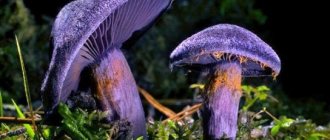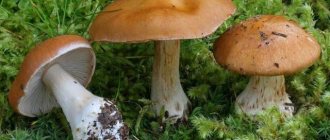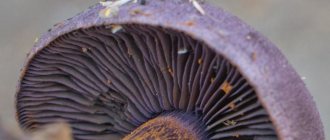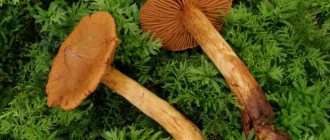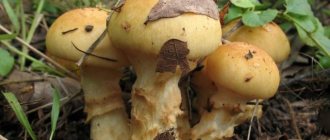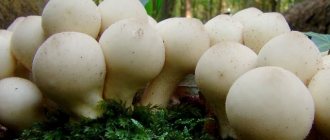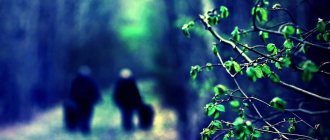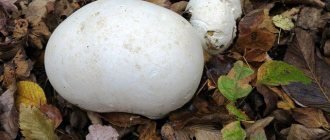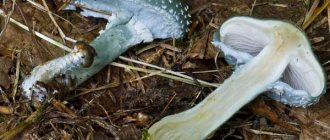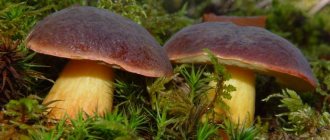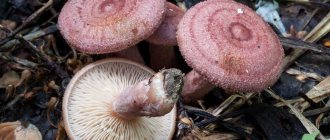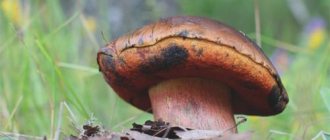The edible spider web (fat one) does not have the most memorable appearance, which is why it is often mistaken for toadstools. However, knowledgeable mushroom pickers will never pass by this representative. It has a distinctive taste that is comparable only to porcini mushrooms. This type is also called fatty. It belongs to the Cobweb family.
What does the spider web mushroom look like and where does it grow?
The name cobweb refers to a genus of mushrooms of the same family. Among mushroom pickers, the popular name “marshland” is quite common, which reflects the characteristics of the growth of the fungus. The mushroom received its main name due to the fact that at the junction of the stem and cap it has a kind of cobweb, which practically disappears as it grows. Cobwebs grow mainly in deciduous or mixed forests, but certainly on very wet soil: both next to a swamp and in lowlands and ravines.
These mushrooms are distributed almost everywhere in the temperate climate zone of our country - from the European part and the Urals to Siberia and the Far East. They can be found less often in the taiga, since most varieties do not like too shaded places.
Interestingly , in appearance, different types of spider webs differ quite strongly, and novice mushroom pickers can mistake them for completely different families. There are fruiting bodies of both classical shapes and mushrooms with spherical and conical caps. The surface can be either dry or slimy, with a smooth or scaly texture. The color of the caps is also quite varied: yellow, orange, brown-red, burgundy and even white-violet.
Cobwebs also grow singly, but more often in families of 10 to 30 pieces. They should be looked for in the lowlands, and are collected mainly at the end of summer and until the onset of the first autumn frosts (late October in the European part of the country and the second half of September in Siberia).
False doubles
The fat one is rare, and its appearance is quite specific; it cannot be confused with other species.
| Name | hat | Place of growth | Danger |
| bbw | The hat reaches 12 cm, light, beige-brown | Prefers pine forests | Edible |
| Inflated cobweb | The cap is small, grows no more than 8 cm, whitish, clay-yellow | Grows in oak groves | Conditionally edible |
| Various cobwebs | The color of the cap is darker yellowish or reddish | Grows in both coniferous and deciduous forests | Conditionally edible |
| Lazy web spider | Clay-yellow cap, densely covered with red scales | Can be found in deciduous, mixed and coniferous forests, loves acidic soils | Inedible, poisonous |
No dangerous look-alikes or poisonous similar mushrooms were found, possibly due to the small distribution area and its insufficient knowledge. The lazy web spider is not called a double because it has too obvious visual differences.
Photo gallery
Interesting facts about yellow web spiders
There are several facts associated with yellow marshlands that mushroom pickers will be interested to know about:
- The second name of the mushroom, triumphal cobweb, is due to its golden hue, reminiscent of the color of the golden crown of Roman generals.
- Since the yellow cobweb often grows next to the black milk mushroom, mushroom pickers often refuse to collect it, opting for the more famous mushroom. Therefore, cobwebs do not appear in recipes as often as they could.
- If you break the cap of the marsh grass in half, its flesh will not change color, but will dry out quite quickly.
Many mushroom pickers note that yellow cobwebs, when boiled, produce a very clear and beautiful broth. Interestingly, after processing, the mushroom retains its shape and has a pleasant crunchiness.
Nutritional value and taste of spider webs
Some types of spider webs are edible mushrooms. In terms of aroma, they are inferior to the classic representatives - porcini mushrooms, champignons and many others, since they are practically odorless. However, the taste of these representatives is quite pronounced. And if you consider that many varieties are large in size (15-17 cm in cap diameter and up to 10 cm in stem height), mushroom pickers readily collect them for cooking and preservation.
In addition, the spider web, like many other mushrooms, mainly consists of water, and 100 g of live weight provides no more than 30 kcal.
THIS IS INTERESTING
Some types of spider webs, which have red and orange shades, are still used to prepare the corresponding dyes.
Tapinella panuoides (lat. Tapinella panuoides)
Name
Tapinella panus.
Latin name:
Tapinella panuoides.
Other names:
Ear mushroom, Paxil panus, Mine mushroom.
Division:
Basidiomycota.
Class:
Agaricomycetes.
Order:
Boletovye.
Family:
Tapinellaceae.
Genus:
Tapinella.
Poisonous mushroom.
Name:
Tapinella panus.
Latin name:
Tapinella panuoides.
Other names:
Ear mushroom, Paxil panus, Mine mushroom.
Division:
Basidiomycota.
Class:
Agaricomycetes.
Order:
Boletovye.
Family:
Tapinellaceae.
Genus:
Tapinella.
Poisonous mushroom.
Scientific synonyms
Agaricus panuoides Agaricus atrotomentosus Paxillus panuoides Rhymovis panuoides Crepidotus panuoides Plicaturella panuoides Serpula panuoides
Very short, or not at all, does not differ in color from the cap.
hat
30–80 mm in diameter, has a lateral attachment to the substrate (sessile), less often with a rudimentary stalk, prostrate or dome-shaped in the shape of a tongue or fan, at first the edge is tucked in, then often uneven, wavy. The skin is dry, in young fruiting bodies it is slightly velvety, yellow-cream in color. As it grows it becomes bare, the color changes to yellow-ocher, ocher-brown, yellow-brown or orange-brown. Mushroom caps often grow together.
Hymenophore
Lamellar, the plates are frequent, radiating from one center, narrow, anastomosing at the base, whitish, yellowish-brownish, brown.
Whitish or dirty yellowish, the smell is not expressive.
Habitat
They grow in forests, on stumps, dead conifers, singly or in groups; this mushroom also likes to grow in cellars and basements.
Similarity
Tapinella panuoides is similar to a mushroom such as Pseudomerulius curtisii, which is distinguished by a merulus-shaped hymenophore with a different color.
| December | January | February |
| March | April | May |
| June | July | August |
| September | October | November |
The nutritional value
It is considered a poisonous mushroom, this is primarily due to the fact that the mushroom contains lectins that cause red blood cells to stick together.
Is the spider web mushroom edible?
Different types of spider webs are classified as edible and inedible mushrooms. At the same time, 3 types are considered the most valuable in terms of taste:
- triumphal;
- bracelet;
- excellent.
The classification of different species depending on their edibility is given in the table.
| view | edibility category |
| yellow (triumphal) | edible |
| bracelet | |
| excellent | |
| white-violet | conditionally edible |
| orange | |
| scarlet | |
| volatile | |
| brown | |
| smeared | |
| straight | |
| sisopeduncular | |
| red-olive | inedible |
| scaly | |
| noble | poisonous |
| brilliant | |
| very special | deadly dangerous! |
THIS IS INTERESTING
Antibiotics are extracted from poisonous species of mushrooms, so they are used as a medicine with antibacterial and antiseptic effects.
Cooking recipes
The unsurpassed taste of the plump mushroom is appreciated by many lovers of quiet hunting who were lucky enough to find this mushroom in the forest. It is good in any form, but especially marinated and fried. If you meet a fat one in the forest, then you definitely need to cook it and try it.
Primary processing
Even if the mushroom is quite clean, it is worth inspecting it for the absence of rot and worms. Before proceeding with further preparation, the fatties should be washed.
Cooking
To boil the plump mushroom, you will need water and salt. For 1 kg of fruit you will need:
- Add 1 tbsp to 2 liters of water. l. salt.
- Boil.
- Then immerse the mushrooms, washed and cleared of forest debris.
- Boil for 10–15 minutes.
Then you need to drain the water and leave the fruits to cool.
How to cook pickled spider webs for the winter
In order to have a delicious delicacy from forest gifts on hand in winter, you will need:
- Edible cobwebs – 2 kg;
- salt – 2 tbsp. l.;
- sugar – 1 tbsp. l.;
- vinegar - 2 tbsp. l.;
- cloves, laurel, allspice - 4 pcs.;
- horseradish, currant and cherry leaves - 4 each.
Then you need to marinate the mushrooms, which have been previously peeled and boiled:
- Mix spices with salt and sugar in a container of water.
- Bringing the marinade to a boil, add vinegar and after 30 seconds the fatty ones.
- Cook for another 15 minutes, at the same time put horseradish, currant and cherry leaves into 4 half-liter jars.
- The fruits are placed in the prepared container and the marinade is poured over them so that it covers their surface.
- Then the containers are sterilized for 30 minutes and closed with lids.
Mushrooms should be stored in a cool, dark place.
Freezing
To freeze after boiling plump mushrooms, just cool them, then place them in prepared containers and place them in the freezer. They can be taken out in portions as needed.
Frying
The edible cobweb itself has a very pleasant aroma and sweetish taste, and therefore there is no need for long cooking. You can fry fresh mushrooms, pre-boiled or frozen. Depending on this, the preparation procedure differs, the composition of the ingredients will be the same:
- mushrooms – 1 kg;
- onion – 200 g;
- salt, pepper to taste;
- vegetable oil – 20 ml.
Preparation:
- Fresh mushrooms are cleaned of forest debris, washed, and, if necessary, cut into pieces.
- First, finely chopped onions are fried in a small amount of fat or oil.
- After the onion has reached transparency, prepared mushrooms are added to it.
- The mass is fried until golden brown, after which it should be salt and pepper.
Interesting! Lovers of delicate dishes can add sour cream - this will give them a creamy taste.
If the mushrooms are pre-boiled, the frying procedure will take less time, since the plump ones are already ready and there is no need to simmer them for a long time on the fire. And frozen mushrooms can be thrown into a frying pan along with onions.
Pickling
For pickling, it is better to use boiled spider webs; for cooking you will need:
- salt – 3 tbsp. l.;
- cloves – 3 pcs.;
- horseradish leaves – 3 pcs.;
- allspice peas – 3 pcs.
The amount of spices depends on the volume of mushrooms; the calculation is per 1 kg of fruiting bodies.
The preparation is as follows:
- Sprinkle the bottom
- Then add a layer of mushrooms and spices.
- Repeat everything until the fruits are gone. Sprinkle the top with salt and cover with a cloth.
- Press the mass with a weight and place it in a cool, dark room.
After 3-5 days, a liquid should appear that completely covers the mushrooms. The fabric should be periodically washed or replaced with a new one, this will help protect the pickles from mold. After 2-3 weeks you can try.
Drying
Drying edible spider webs is very simple. The mushrooms must first be cleaned and all damaged, rotten or wormy fruits removed.
Important! Before drying, fatties are not washed in water.
Then the large caps are cut into pieces so that all the mushrooms are approximately the same size. You can easily dry them on a thread by stringing them and hanging them in a sunny, ventilated place, or in the oven. In the second case:
- The temperature inside the oven should be 50-60 degrees.
- Place the mushrooms on a baking sheet and place them inside.
- Periodically, they should be turned over and their location relative to the heating elements of the device changed.
Dry fatties should become brittle, without the presence of moisture. Store them in canvas bags or closed glass jars, away from strong odors, in a dry place.
Description of spider web species
The Cobweb family includes several dozen species of mushrooms, and most of them grow in Russia. The most common ones are discussed below.
Yellow cobweb
This representative is also called triumphant. It forms fairly large fruiting bodies with a cap diameter of up to 12 cm. Moreover, in young representatives it resembles a sphere and then becomes flat. Color ranges from yellow to brown tones.
The pulp of this species does not have a special odor and dries quite quickly when broken . On the other hand, this is the most popular member of the family among mushroom pickers, since its taste allows it to be used as the basis for first and second courses, as well as for pickling and pickling.
Bracelet web plant
This representative is also called red. It has a classic shape - a spherical cap of orange, ruddy and reddish shades (about 10 cm in diameter). The leg is white, fleshy, and can grow to a considerable height (up to 20 cm).
The mushroom is completely edible , and also has an undeniable advantage - it is not like closely related poisonous or deadly representatives. However, it is not popular enough among mushroom pickers. Interestingly, it grows only under birch trees.
The web spider is excellent
This is a rather rare species, which is mainly found in Central Europe, and in Russia it is distributed only in the forests of Bashkiria. It almost always grows in large families, so mushroom pickers immediately collect large harvests.
In appearance, it resembles real mushrooms from postcards: a large cap in the form of a hemisphere with rich brown, brown and burgundy shades, as well as a glossy surface (15-20 cm in diameter). The legs grow up to 14 cm in height, dense, fleshy, white.
THIS IS INTERESTING
In the Cobweb family, this species is considered the most valuable in terms of taste. However, it is extremely rare, so in most European countries it is listed in the local Red Books.
White-violet
This is a conditionally edible representative that does not have any particular taste value, but nevertheless, it can be eaten without fear for health. The dimensions are not very large - the diameter of the cap is within 8 cm, the height of the stem is up to 10 cm. The color is quite atypical: from white to lilac and dirty shades. It mainly grows in groups of up to 10 mushrooms and is found mainly in birch and oak forests.
NOTE
This variety is similar to the inedible goat's web. The pale purple variety is characterized by an unpleasant odor and a thinner, taller stalk.
Scarlet
This species is also classified as conditionally edible. It has a light brown, rather large cap (up to 15 cm), which is almost fused with a thick (1-1.5 cm in girth) stem. Interestingly, the flesh has a light blue tint when cut, but quickly turns red when exposed to air.
And one more interesting feature - despite the fact that the pulp of this variety has a fairly strong aroma (unlike most other types), it tastes neutral, so this species is not particularly popular among mushroom pickers.
Red-olive
An inedible species, the consumption of which can cause poisoning. The cap is up to 10-12 cm in diameter, the surface is mucous to the touch, and spherical in shape.
The color of the leg is interesting - if it is purple on top, then in the lower half it acquires red shades. The flesh tastes extremely bitter, and when cut it has olive and purple hues, which is how the species got its name.
Brilliant
A poisonous representative, the consumption of which is hazardous to health. It looks very beautiful - it has brown caps with a shiny surface. However, the pulp, even in heat-treated form, causes severe poisoning, and in large doses can be fatal.
The most special
This is the most dangerous representative, the use of which is strictly prohibited even in small quantities. The color is light, cream and yellowish. An interesting feature is that the pulp smells like radishes or raw potatoes. The cap reaches a diameter of 12 cm, the stem is up to 10 cm in height.
In terms of toxicity, this mushroom is almost identical to the toadstool, but it is quite easy to identify by its appearance. In addition, none of the edible representatives of the Pautinnikov family and other families are similar to this species.
Distribution and collection
Fatty.
It grows, as a rule, in the western regions of Russia, as well as in Ukraine and Belarus. It prefers soils rich in humus and manured, so it is often found in pastures, near barnyards and stables, on rotten garbage heaps, and in gardener's beds.
It grows from June until the first frost, with peak fertility in September.
Similar mushroom species
The white-violet cobweb is quite often confused with the violet row, but unlike it, it belongs to the class of completely edible mushrooms. The row can be distinguished by its aroma - if you sniff the plates under the cap, you will notice a distinct fruity smell.
Some types of spider webs are very similar to each other, so they can only be distinguished by experienced mushroom pickers or even scientists. For example, the double-ringed webwort is very similar to the bulbous and woolly webweed. As for edible representatives, you need to collect only those about which you have complete confidence.
Useful properties and applications
The mushroom has a distinctive sweet taste and a very pleasant aroma. It is also highly valued by experienced mushroom pickers due to its large size. In cooking they are used both fried and salted. The mushroom is quite low in calories, so it is suitable for people on various diets. The beneficial properties include a large amount of B vitamins. However, it is not recommended to use edible spider webs for children under 7 years of age and pregnant women. People who suffer from diseases of the stomach, kidneys and liver should also be wary.
Primary processing and features of preparing spider webs
With edible types of these mushrooms, you can perform all culinary procedures - fry, stew, boil and preserve for future use. Certain species, for example, superb cobweb, are well suited for drying.
These mushrooms do not require special preparation techniques, but not all types are suitable for all processing methods, for example:
- yellow is only salted and dried;
- white and purple are mainly fried and boiled;
- dove-blue requires a long boil, after which it can be pickled;
- scaly is consumed only in boiled form.
Treatment for poisoning
An ambulance should be called as soon as the first symptoms of poisoning appear. Before the doctors arrive, the patient is given plenty of fluids to drink. Strong herbal tea without sugar or purified water at room temperature has a good effect. This allows you to cleanse the stomach and remove more toxic substances.
To stimulate the release of toxic substances from the body, the following means are used:
- Smecta;
- Enterosorbent;
- Enterosgel;
- Activated carbon.
In case of severe poisoning, a laxative or enema helps. This significantly enhances the release of harmful substances from the stomach.
Strong herbal tea without sugar helps with poisoning
Contraindications for first aid:
- take medications that improve the functioning of the gastrointestinal tract (digestion will delay the entry of poison into the blood);
- give enemas to older people;
- cause a gag reflex in children under 3 years of age and in pregnant women.
Doctors hospitalize a patient who has been poisoned by mushrooms. He is prescribed drug detoxification. The type of procedure depends on the amount of toxic substances in the body, as well as the physiological characteristics of the patient.
Detoxification methods:
- gastric lavage;
- hemodialysis;
- enema.
Recovery after poisoning
After detoxification, patients are restored to water and electrolyte balance in the body. For this purpose, antibiotics are used in the form of tablets and injections. In acute cases of mushroom poisoning, IVs are given. To recover, the patient is prescribed a special diet.
Rules for nutrition after poisoning with pork fat:
- You should not eat fried, smoked, fatty or spicy foods;
- giving up alcohol and cigarettes;
- You should eat boiled or steamed food;
- You can only eat chopped fruits and vegetables.
Contraindications for use, possible harm
Photo and description of the flywheel mushroom: edible and false species, how to collect and cook.
Purple cobweb can cause painful symptoms by causing metabolic disorders. This happens when the product is abused. The description and photographs will explain what harm the mushroom can cause to the body, and to whom the product is contraindicated.
It is forbidden to consume purple marsh grass if you have the following diseases:
- hypervitaminosis (destruction of the skin and cartilage tissue may occur);
- diseases associated with the gastrointestinal tract (due to the eaten mushroom, a malfunction in the digestive system will occur, which will entail the development of pathogenic microflora);
- individual intolerance (resulting in nausea with vomiting, stomach cramps, increased salivation, gases in the intestines and stool disorders);
- epilepsy (seizures, severe headaches and muscle cramps appear, accompanied by dizziness and loss of consciousness).
If you abuse violet marsh grass, the following consequences may appear:
- an allergic reaction manifests itself in the form of nausea with vomiting, dizziness, frequent flatulence, fainting, runny nose and swelling of the mucous membranes;
- failure of metabolic processes, which results in dehydration of the body, severe headaches, weakened immunity and poor blood clotting;
- acute interstitial nephritis, which results in inflammation of the kidneys, which entails the development of sinusitis, rapid heartbeat, excessive sweating and sore throat;
- toxic shock causes loss of consciousness, skin necrosis, muscle aches, apathy, weakness, redness of the mucous membranes and high fever;
- an increase in bladder tone, which causes calcium to be washed out of the bones, sleep is disturbed, irritability and increased urge to go to the toilet appear.
When collecting mushrooms, the procedure must be carried out as far as possible from roads, since the fruiting bodies are capable of absorbing pathogenic microflora. As a result, they cannot be included in the diet.
Doubles and their differences
In terms of external features, the described gift of the forest is similar to the diverse cobweb. The double is a conditionally edible mushroom, but can be used for food only after preliminary processing. It differs from the specimen in question in having brown colored caps and a tuberous stalk at the base.
The pulp of the double does not have a pronounced taste or smell
